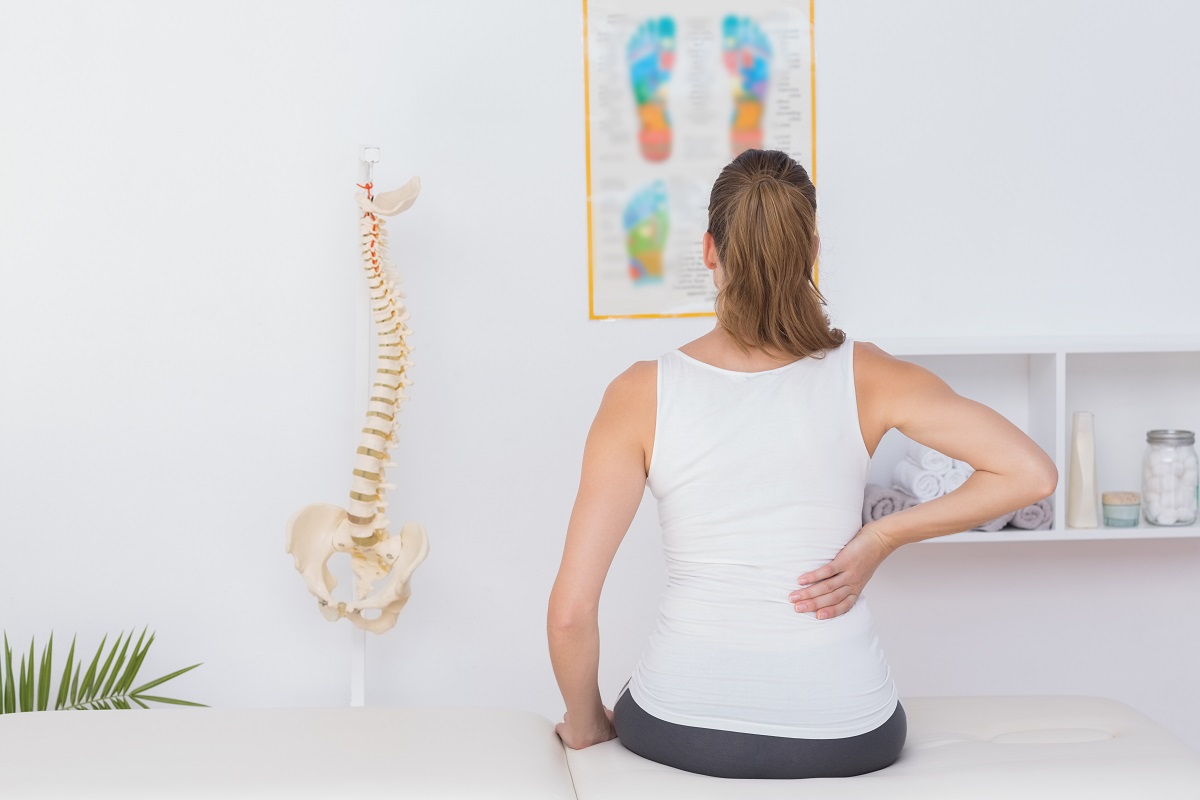Back pain is a problem that affects millions of people around the world. There are countless causes of back pain, which can include accidents, injuries, degenerative conditions, as well as a sedentary lifestyle. Simple things like chronic poor posture, and not having enough flexibility, can also lead to back injuries when stooping down or lifting.
It is important to know that back pain is a condition experienced by people of all ages and lifestyles. Back pain sufferers have many different lifestyles and it is not an affliction experienced by only certain groups of people. Back pain affects many areas of a person’s life, from sleeping to sitting, to being active in sports, and when it is present it affects nearly everything you do. However, it does not have to be an affliction that you simply must live with.
There are many different treatments for back pain, depending on its cause and severity. Knowing your options for how to best treat your back pain will ensure you make an informed decision. There are ways you can be free of your back pain, and prevent it from recurring in the future.
Before we go into the treatments that can help with your back pain, it is important to understand how the back works, and how your back pain may have occurred.
The Anatomy of the Back
The back is a complex area and provides a great deal of support for our bodies. It is constantly required to bend and flex, and helps to keep us upright. The spine consists of 24 bone segments, referred to as vertebrae. Each vertebra has a bony part jutting out from it consisting of two facet joints. These joints meet the joints of the vertebrae above and below it, and they act as a type of hinge. These joints have a cartilage layer, which protects them at their point of contact with the next vertebrate joint. In addition, the two facet joints are covered in what is referred to as a capsule. This capsule is a membrane that is filled with synovial fluid, which lubricates the joints. The spinal cord runs through a channel or opening between the vertebrae and facet joints.
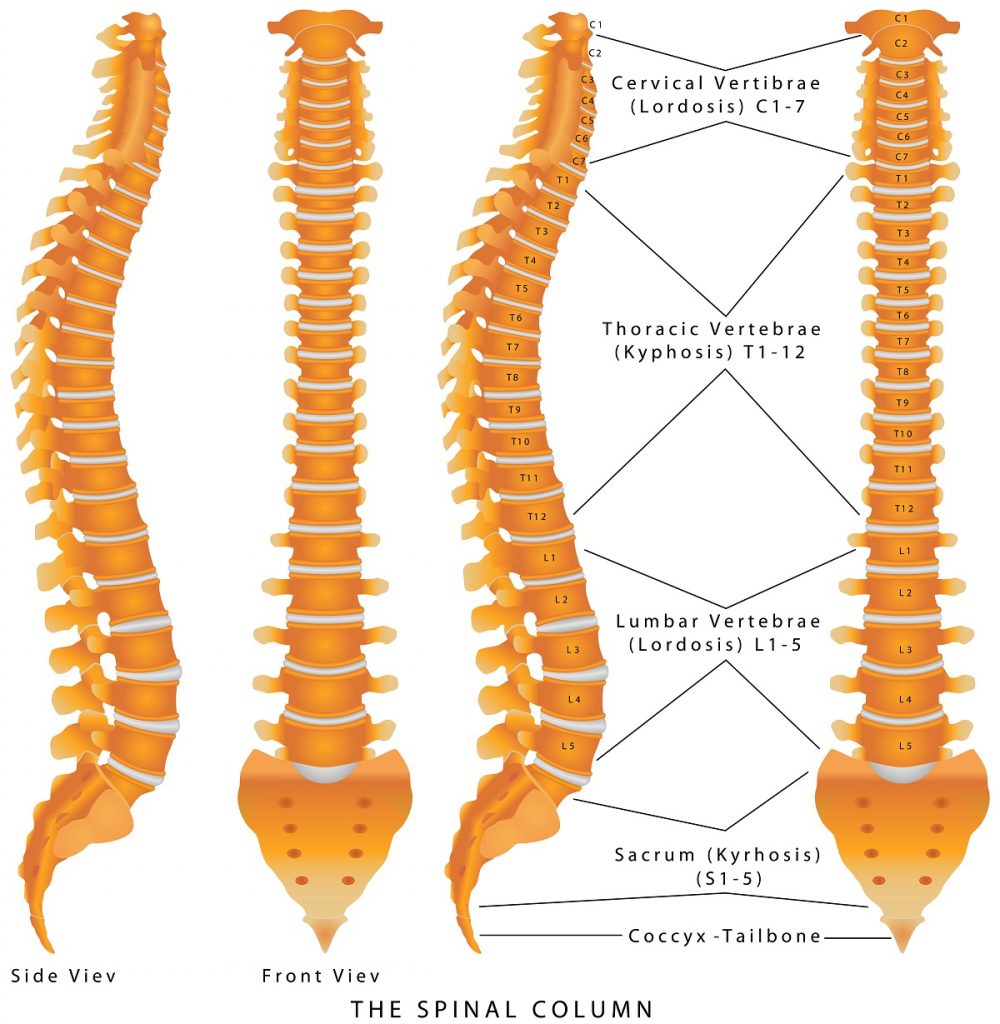
In between each of the vertebrae are little cushions called disks. They are basically porous, spongy, elastic membranes that contain fluid. The disks act like shock absorbers, and they are attached on either side to the vertebrae. The discs have a nucleus at the center, which has the consistency of jelly, surrounded by fluid. The discs stay hydrated by getting nutrients and moisture from the surrounding area through a pumping action. As your back moves, the vertebrae bend, flex, and move in all directions, and by doing this they stay hydrated. If this pumping motion doesn’t occur, the discs can dry out, and basically start to die.
The spinal structure is completely wrapped in ligaments, which crisscross the entire area completely enclosing it. It is designed to allow bending, flexing and twisting motions, while providing protection for the complex and delicate structure.
Our bodies are meant to move, so the prevalence of sedentary lives that many busy office workers are leading, can lead to injury and chronic back pain. However, these situations do not just occur with accidents or injuries, often times too much sitting and too little exercise is as harmful to the back as traumatic injury. When we constantly have bad posture, what is happening is that we invariably slouch, and often lean forward. Over time, the ligaments and muscles that surround your spine become used to that position. The ligaments that are at the front at your spine will shorten because they aren’t being properly stretched out. In addition, the ligaments that are at the side and back of your spine are stretched too much. This leaves us vulnerable to sudden movements that stretch the muscles and ligaments beyond what they have become accustomed to, which can then lead to tears and injuries. When these tears heal, scar tissue develops over top of them. Scar tissue is stiffer and less able to stretch, and in fact shrinks over time leading to a muscle or ligament that is both shorter and less pliant, which can lead to even more injuries. In addition, we often revert to our usual poor posture, which makes the problem even worse. This scenario can be repeated many times throughout the course of a person’s life, resulting in limited mobility, chronic stiffness and soreness, and damaged muscles and ligaments. A sudden strain on the already compromised area can lead to an even more serious injury.
It is a natural instinct to protect an injured area, so while we think we are protecting a weak and vulnerable spot, what we are actually doing is impairing it’s healing, and making the problem worse over time. The muscles and ligaments grow shorter and less able to respond with full range of motion, so it becomes easier and easier to push them past their reduced points of no return. Little by little, we hunch over further, use the area less and less, and create our own cycles of chronic pain.
Many people think that sitting is a neutral position. However, if we sit too often without taking a break or changing positions, sitting can be one of the most damaging things we can do for the lower back. The sitting position actually applies a compressive force down the lower back region, continuously squishing and pinching the soft disks between our vertebrae. Eventually, the disks lose their sponginess and moisture. Combining this with a lack of the necessary nutrients and moisture they get from the pumping motion that occurs with regular movements, they begin to deteriorate, becoming thinner and flatter. Their ability to absorb shock is then greatly diminished.
Your body also acts to protect injured areas, so it is common that the muscles around the compromised disk will contract in an effort to become tighter to act as a protective shield around the disk. Now you have a twofold problem – a less pliable and drier disk, which can’t cushion the area of the spine from the shock of regular movement, as well as tight muscles, which don’t relax. As these muscles continue to try to protect the disk, they actually end up putting additional pressure on it, and the disk begins to be pushed towards the nerve and spinal canal. This is a bulging or herniated disk, and is an extremely painful condition that can take months to heal. It can even worsen when the inner jelly sack, called the nucleus, pushes through the outer disk membrane. This is a ruptured disk that often requires surgery to correct. Surgery to fix a ruptured disk involves cutting away the matter that is extruding, so it is no longer in contact with the nerve. This painful operation is both risky and requires a very long healing process.
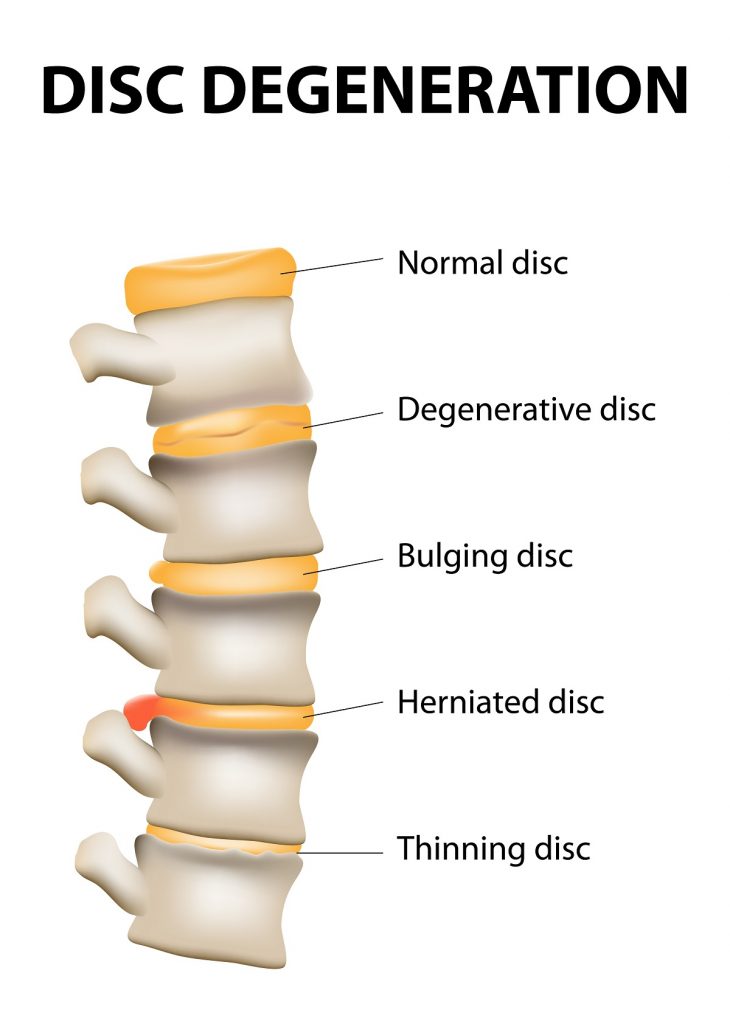
As the disks between the vertebrae flatten, they no longer have as much space between them, so the joint facets start to rub against one another, creating more pain and friction. As the disks continue to dry out, they can become permanently damaged. This is an irreversible situation and is extremely painful because there is no longer any cushion between the vertebrae, which now rub together and can become fused.
This is why it is critically important that regular exercise, changing positions and stretching, should be incorporated into your daily life. These troubling back situations can result from many years of poor posture, sitting, and inactivity. It doesn’t just take a traumatic injury to create serious back problems and chronic back pain. If left untreated back pain can lead to serious loss of mobility and reduced enjoyment of your life.
Symptoms of Back Pain
Symptoms of back pain vary widely based on the type of injury, disease, or other underlying condition. Common symptoms include twinges, mild or moderate soreness, (which can sometimes feel like a bruise), aches, and varying degrees of pain, such as dull, generalized pain, or more acute, localized pain. Should you experience back pain that is quite severe in nature, seeking medical attention is advised. Sharp or severe back pain may indicate a muscle tear, a bone fracture, or it may signal that one of the bones in your spine is out of alignment and pressing on another area.
Many people experience back stiffness, and joint pain, and an over all achiness as a regular part of their everyday life. Starting when they get up in the morning, to the end of a busy workday, they may notice ongoing discomfort. Barring a serious underlying cause or injury, people who maintain poor posture throughout their day typically experience some back pain symptoms. They may feel stiff and sore simply getting out of a chair, after sitting for many hours.
In addition, people may experience specific back pain related to certain movements. This includes getting a sharp pain when raising an arm, or when twisting, bending, straightening, walking, or lifting something. Rather than an ongoing general sense of stiffness and soreness, this type of back pain is more localized.
It is important to be in tune with your own body, so that you know what causes your back pain to occur, so that you can communicate this to your doctor or therapist. You also need to be aware of your physical limits when performing certain activities such as sports, lifting, or other forms of exertion. Your body will give you signals along the way to tell you when you are reaching your limits, and you would do well to heed those signs.
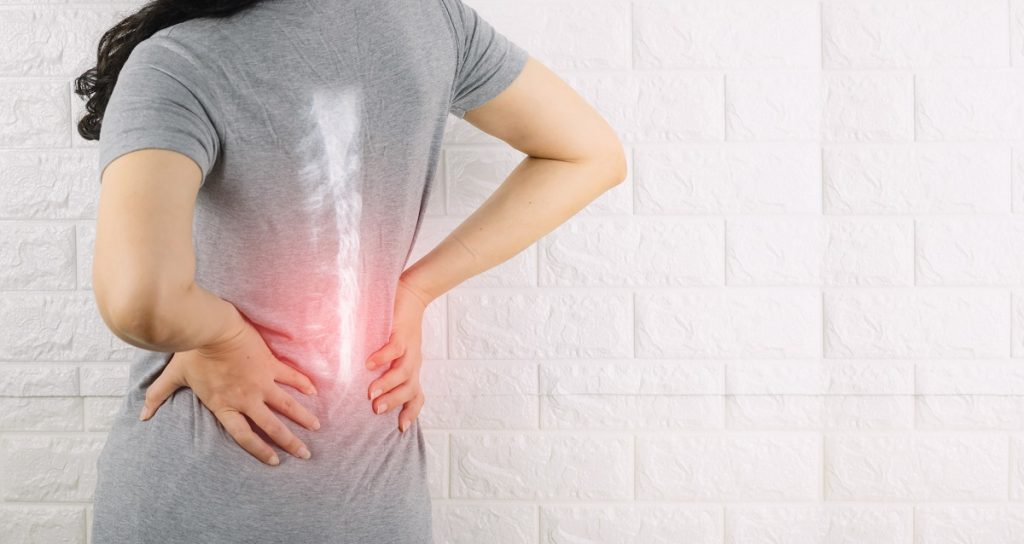
If you have experienced noticeable back pain for a week or more, you should seek treatment. People often think that if they just wait it out the pain will go away. However, this can lead to a more serious condition that will be harder to fix. Simply treating your back pain with painkillers over a long period can have other negative effects on your body’s systems. Painkillers simply mask pain, but pain is actually your body’s way of telling you that there is a problem. Therefore, it is extremely important to pay attention to what your body is trying to tell you. Pain is only a symptom, so treating it is only treating the symptom, not the cause. You need to get to the underlying root of the problem.
The Various Treatments for Back Pain
Massage therapy
Massage therapy involves a passive treatment whereby the patient receives deep muscle work that may restore proper blood flow to areas of muscle that have become knotted and tight. It can also help to break down scar tissue that has built up over injured muscles and ligaments. However, since these problems have escalated over time, they also require time to be healed and corrected. Using massage therapy on its own will not be sufficient to correct muscles and ligaments that have shortened and have developed scar tissue. To receive longer-term benefit, the patient must follow a stretching and exercise regimen, tailored specifically to the damaged or injured area. In addition, deep tissue massage can lead to bruising of the area, which may take a few days to heal. It is important to know your limits, and communicate these to your massage therapist so that you don’t end up in more pain than when you started.
Chiropractic treatments
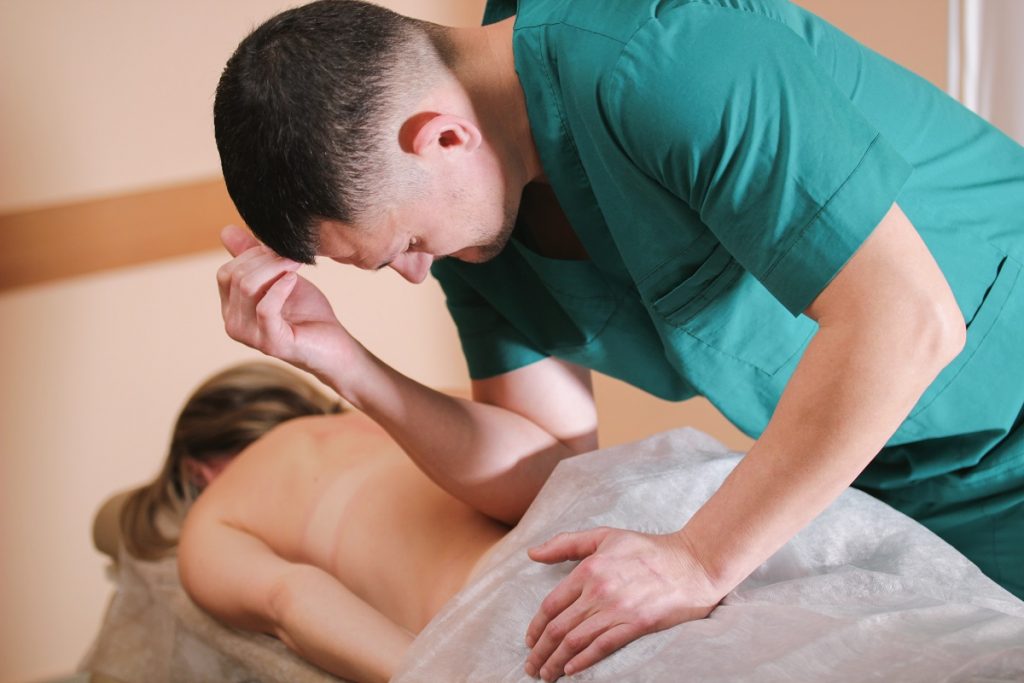
Chiropractic treatments involve forcibly manipulating the spine. Treatments can be painful, and are often required over long periods of time. The goal behind a chiropractic adjustment is to put the spine back into proper alignment. Many people expect that once their back has been adjusted into correct positioning, it should stay there. However, as we learned in the anatomy of the back section, the muscles and ligaments surrounding the spinal column will have adjusted over time, placing the vertebrae into an improper position. They will shorten, and develop scar tissue in these areas. Adjusting that specific area will only lead to temporary relief, because the muscles and ligaments will pull the vertebrae back out again. Simply seeking repeated chiropractic treatments will be of no benefit if the muscles and ligaments are not treated as well. This may involve massage therapy or physiotherapy, which can begin to break down scar tissue and retrain the muscles to behave more normally. However, daily lifestyle habits must also be changed to get these muscles and ligaments moving properly, so they can retain new muscle memory and break free of old habits. It is an integrated problem that requires an integrated solution. Chiropractic on its own will not do the trick. Further, chiropractic treatments may actually exacerbate underlying problems such as disk degeneration, or bulging disks. As with any treatment, if it is found to be painful it may make the situation worse.
Decompression
Decompression therapy is a newer form of treatment for disks that are herniated or bulging, or that have deteriorated. This involves looking the patient up to a machine, which is programmed for the person’s height, weight, and the location of the problem. The machine essentially works to stretch out the area, which is supposed to allow fluids and moisture back to rehydrate the disk. As the machine applies a pulling motion, the muscles in the person’s back will tighten to compensate. However, the machine is programmed on an algorithmic curve to compensate faster than the muscles. The muscles can react so that they prevent the area from being pulled. Decompression therapy is often combined with chiropractic adjustments and massage therapy. It is a very expensive form of back pain treatment because of the high cost of the machines. Patients are often required to pay several thousand dollars to cover the course of treatment, and not all insurance companies cover these costs. As well, because this is a newer form of back pain and back treatment therapy, long-term studies that either prove their effectiveness or justify the cost, have not been completed. Further, although there have been no reported benefits from decompression therapy, there have also been complaints of injuries received from it.
Physiotherapy
Physiotherapy involves a number of treatment courses, which may include muscle work, stretches and exercise, injections, traction, water therapy, heat and cold therapy, ultrasound, muscle stimulation, and occasionally spinal adjustment. A physiotherapist will design a treatment based on the specific injury or chronic problem. Treatment often requires several weeks, and comes at a high cost, but most insurance plans will cover it to an extent. The benefits of physiotherapy are that it includes muscle work and stretching, so that the compromised muscles and ligaments are slowly retrained. It is a more integrated approach than chiropractic or massage therapy alone, because it considers how the muscles, ligaments and bone structure are working together, and provides a course of treatment to achieve a better overall result. However, it is up to the patient to continue exercise and stretching programs in order to receive long-term healing benefits. Once again, physiotherapy alone will usually not be enough.
Surgery

Surgery should always be the absolute last option considered for back pain issues, damage, and injury. Many doctors are often reluctant to encourage surgery as an option unless all other avenues of treatment have been explored first. The reason for this is that surgery is always invasive. It requires slicing through healthy tissue in order to surgically alter and correct the damaged area. Any time you open up the body, you are putting it at risk of exposure to potentially deadly infections. In addition, you will end up with a mandatory long healing process while the areas subjected to surgery heal. Often times people will have new problems to contend with because of surgery, as well as only receiving a partial benefit that is less than they had hoped to achieve. These problems can crop up long-term as well as in the short term. Our bodies are not meant to be cut open, sliced and diced, so surgery should only be considered as an absolute last resort. It is also a good idea to seek more than one medical opinion when considering surgery, as well as exploring all other alternative avenues of treatment beforehand. Surgery by nature will cause damage to tissue, opens the body up to infection, and requires anesthesia. Anesthesia is a powerful drug, and can be dangerous. Therefore, a great many risks must be taken into account before deciding on surgery. It is also not uncommon to receive differing diagnoses and recommendations, even with x-rays, CT scans, and MRIs, which is why it is essential to really do your homework beforehand.
What Should You Aim for in Treating Your Back Pain and Back Problems?
Human beings are not robots and do not come out of perfectly formed molds. There are always going to be underlying problems and abnormalities, so it is important to remember that we are not trying to get back into an earlier state of perfection but rather a comfortable, pain free life. We are natural beings of the natural world, and as such, our bodies will always have an element of wear and tear to them — that is just part of our existence.
What we should be aiming for is high-level of functionality, which involves flexibility, strength, and ability. We want our muscles and ligaments to be able to respond well to movement, without being hampered by pain and injury. This is achieved through good posture, regular exercise, and stretching. If you have experienced an injury, it is important to allow the injured area to rest and heal before you start to push it. This allows the muscles and ligaments to knit back together. This process may vary depending on the injury received and age at the time of injury. However, two weeks is typically a sufficient time to allow before beginning a gradual and active course of treatment. On average an injured muscle or ligament will require a couple of weeks to fully heal, while an injured disk may take months to heal. However, that does not mean you need to wait before resuming any kind of physical activity, it only means you will need to proceed slowly and carefully and pay attention to what your body is telling you. During the healing process, you do not want to be completely inactive. Inactivity results in decreased circulation and a lack of hydration for the injured area. Maintaining movement will keep stiffness from setting in and prevents muscles and ligaments from shortening and tightening.
How Can You Help Yourself?
Heat & Cold
– As your muscles and ligaments are healing, there are a number of things you can do to help the healing process. The first step is to alternate heat and ice packs. This helps improve circulation, helps swelling go down, and reduces inflammation. Placing an ice pack on the sore or injured area for 15 minutes will help to numb the area. Then you can follow that by another 15 minutes with a heat pack, which warms the area back up and increases blood flow. You will find this actually feels very good and can provide some quick relief from back pain. This process can be repeated several times during the day, for several days. It is important that you begin with the ice pack, and end with the heat pack.
Deep Breathing
– In addition to the alternating ice packs and heat packs, deep breathing exercises can also be beneficial for pain relief. Deep breathing helps to relax the body and any tight or strained muscles and ligaments. It also has a calming effect, which helps to alleviate stress, and can provide relief for pain in the lower back. Practicing deep breathing is also a great way to improve overall respiration, as it helps to exercise the muscles involved in that process. Additionally, deep breathing works to rid the bloodstream of carbon dioxide, while improving oxygen intake — it can literally help flush out the bad stuff, while promoting a healthy body.
Exercise
– A vital part of helping yourself to become free of back pain is through a proper exercise regimen. This doesn’t mean getting involved in a hard-core training program at a gym. You can actually achieve excellent results with only 15 minutes a day of gentle stretching and targeted strengthening exercises. It is advised that you follow a low impact regimen, to avoid further injury and damage to tissue. Remember to always pay attention to what your body is telling you. This means slow down, or back off. exercises that cause additional pain or are too difficult. Each person should proceed at their own pace and according to their specific situation. A simple rule of thumb is that if a specific exercise feels good and gives you some pain relief then you should continue it.
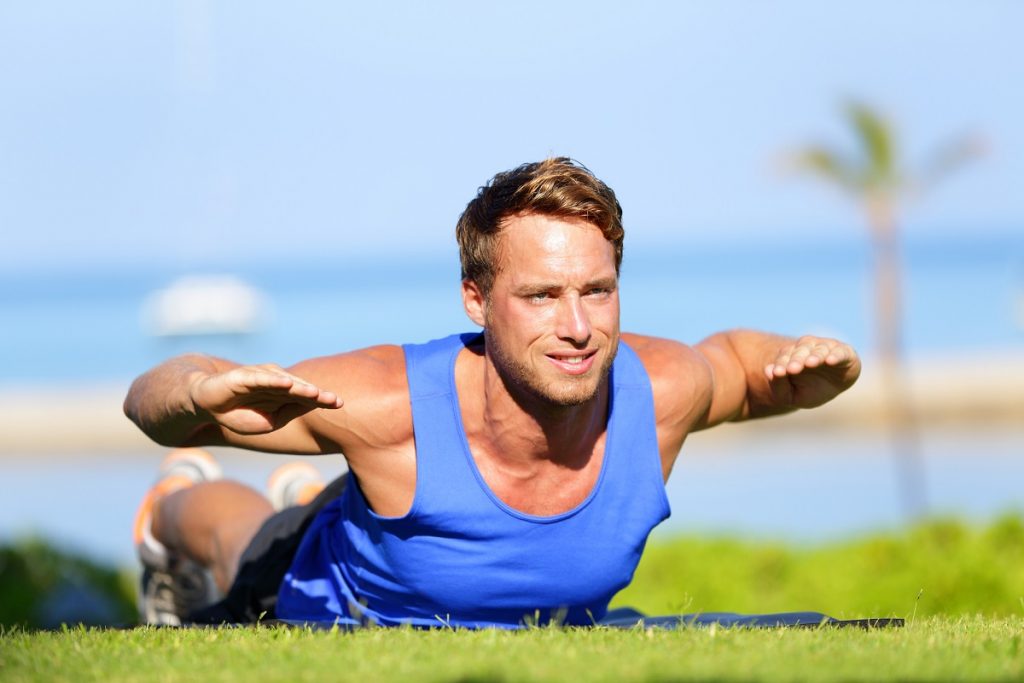
With any exercise program, you should proceed slowly, and gradually build up your strength and flexibility. The following sets of exercises can be done up to six or seven times daily, depending on your fitness and endurance level. It is a good idea to wait a couple of hours in between an exercise set to allow your body to adjust and rest.
Exercise #1
Lie face down on a bed, or cushioned floor or mat, with your arms resting and relaxed at your sides. Turn your head in any direction that is most comfortable for you. Begin breathing deeply and focus on relaxing your back muscles. Do this a number of times until you can feel the tension beginning to dissipate in your back. Next, lift yourself up on your elbows while resting on your forearms. Continue your deep breathing exercises, as your body adjusts to the new position. Then lie back down. If this lifting motion is difficult or painful for you, you can place a soft pillow beneath your chest to achieve the slight bend in your back. If you can manage that, then the next step is to push yourself up with your hands while keeping your legs and hips on the floor or bed. It is similar to a push-up, but you are only moving your upper body. Raise yourself up to a comfortable position — it is important not to strain your back, this should be a gentle motion. Hold the position for 5 seconds, and make sure you do not tense your lower body. You can repeat this exercise up to 10 times, or as many times as you can comfortably manage. Remember not to push yourself too far. Work up gradually and slowly.
This exercise is a great way to combat the continuous slouching we often find ourselves doing while sitting or standing. When you are always using bad posture, your back is slumped forward. This exercise stretches your back out the other way, so it balances you, and relieves built up stiffness and tension in your lower back. Muscles and ligaments that had begun to shorten and become painful are eventually eased back into a healthier, more flexible state.
Exercise #2
This exercise is similar to the first one in that it is designed to stretch shortened muscles and ligaments, when they have become less flexible through slouching or from an overall poor posture. While in a standing position with your feet shoulder width apart, place your palms on the curve of your lower back for support, then gently and slowly bend your upper body back to a comfortable position. It is important to keep your knees straight and once again to not strain yourself. Hold this position for 5 seconds if you can, and repeat it 10 times, if possible, or as many as is comfortable for you to do at this point. If you experience a sharp pain, either ease off the back bend or stop doing it altogether. Again, it is important to pay careful attention to what your body is telling you. This is an easy exercise to perform throughout the day, and is a great break from sitting. You will notice it becoming easier over time, and you will find relief from lower back pain and stiffness.
Exercise #3
While in a standing position, raise your arms over your head and clasp your hands together, with your feet shoulder width apart. Then slowly and gently bend to the side as far as is comfortable. Hold the position for 20 seconds then come back to center and repeat on the other side. This exercise helps to stretch the side muscles, which are often neglected. Repeat this exercise up to 10 times per side, or as many as is comfortable for you to do. Once again, do not push the stretch too far initially, but rather increase the stretch gradually and slowly. Notice how you feel during the stretch – because people are generally right or left-handed, you may notice one side is tighter than the other. In this case you will need to be more patient with the side that is tighter, rather than expecting equal performance right at the start. This is a process of body, muscle, and ligament realignment, and is designed to correct years of poor posture.
Exercise #4
Now that we are getting our upper body moving in a healthy and helpful fashion, let’s also pay attention to the lower body, beginning with the hips. Doing a great deal of sitting, can result in a very tight hip area that becomes painful over time. Therefore, we need to loosen this area. Once again stand with your feet shoulder width apart. Think of shrugging your shoulders, except you’ll also be doing it with your hips. Begin with your left hip, and raise it up as far as is comfortable while simultaneously raising the opposite shoulder. Hold for a few seconds. Then raise your right hip, and lift your left shoulder at the same time. Basically, you are raising the opposite hip and shoulder at the same time. If this is comfortable, you can do it more quickly, instead of giving it a complete stretch. If you can do both easily, then do a few quick shrugs with your hip and shoulder, followed by a long, slow stretch. This particular stretch is very good for your lowest vertebrae, which are particularly prone to bulging, or for herniated discs caused by too much sitting and poor posture. This exercise can be performed throughout the day, and should be alternated with a few of the back bends.
Exercise #5
Another gentle exercise is to lie down on your back, and place your feet on the floor with your knees bent. If this position is comfortable enough for you, you can proceed to pull one knee up towards your chest, and hold it for up to 5 seconds. Do not pull too hard, but rather allow your knee to come up as far as it is comfortable to hold. Then put your leg back down and repeat with the other leg. Again, lower the leg and take a deep breath, ensuring tension is released from your lower back, then pull both your knees up simultaneously and hold for 5 seconds. Make sure that your knees stay bent while you lower your legs, to avoid putting stress on your lower back. While doing this exercise keep your head down on the floor, and do not lift it. Repeat this complete set of three exercises up to five times. Stretch as far as is comfortable for you, and gradually and slowly work up to more full stretches as your body allows.
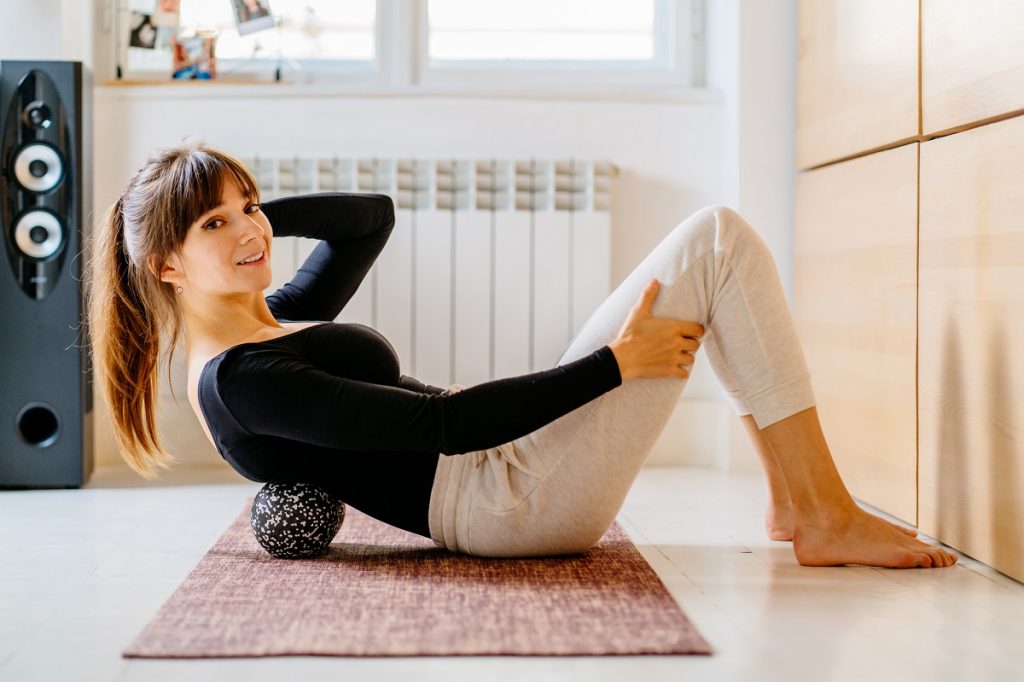
Exercise #6
Since we have already started to do back bends, it is a good idea to move the other way — in a forward bend. We won’t be repeating this one as often as the back bends, once a day is sufficient to begin with. You can gradually build up to 3 to 5 times a day, as your mobility and comfort levels allow. Again, begin by standing with your feet shoulder width apart. Then breathe in deeply concentrating on opening yourself up, and allowing oxygen to get into all of the places that are typically sore and tight. Next, allow your chin to fall towards your chest, and one vertebra at a time, roll forward. This is the motion you would undertake to touch your toes, you are slowly folding in half at the waist. If you haven’t done this kind of stretching for some time, or not at all, do not try to touch your toes right away – that will likely take some time to work up to. In the forward bend position, hold for 5 seconds if you can, hanging limply, then slowly roll up the way you roll down — one vertebrate at a time. It is important to maintain a controlled motion during this stretch, rather than dropping your upper body down — doing that will only strain your lower back and hips. You can repeat this exercise up to three times as your body allows.
Exercise #7
In much the same way as the previous exercises, this next one is designed to stretch the muscles, which have become tight through prolonged sitting. While sitting in a chair, slowly bend forward so that your hands are either touching the floor, the tops of your feet, or your ankles. While in this seated bend position, breathe deeply and hold for 5 seconds. Then just as we did with the forward bend, slowly come back up to a sitting position, concentrating on one vertebra at a time, and then breathe deeply once again. You can repeat this exercise up to five times, or as many times as is comfortable for you. Then, you can proceed to do side bends from this seated position, just as you did while standing. Raise your arms over your head, and interlock your fingers. Then slowly and gently bend to the side, and then to the other side, holding each one for 5 seconds. You can also do a back bend from the seated position the same way you did while standing. Place your palms on your lower back and slowly lean back. Again, repeat this exercise five times. This is a great way to combine many of the other exercises while working at your desk.
